1. Introduction: DJI Redefines the Mini Drone

The launch of the DJI Mini 5 Pro represents not merely an incremental update but a fundamental paradigm shift in the ultralight drone category. For years, the sub-250-gram class was defined by compromise—a necessary trade-off where portability and regulatory freedom came at the cost of professional-grade imaging and advanced flight features. With the Mini 5 Pro, DJI has shattered that paradigm, delivering pro-level power in a palm-sized package and effectively blurring the lines between its consumer-friendly Mini series and its more advanced Air and Mavic lines. This is the drone that proves “mini” no longer means “less.”
The true innovation of the Mini 5 Pro lies in the powerful synergy of three core advancements: a flagship 1-inch sensor, revolutionary LiDAR-powered night sensing, and a suite of enhanced flight performance capabilities. This potent combination makes professional-grade aerial cinematography more accessible, dynamic, and, crucially, safer than ever before. This drone is not just an evolution; it is a redefinition of what is possible within the most popular and accessible drone weight class.
This in-depth review will explore every facet of this groundbreaking aircraft. It will provide a detailed analysis of its game-changing camera system, a thorough examination of its advanced safety and flight features, a direct comparison with its predecessor, the DJI Mini 4 Pro, and a clear explanation of the complex U.S. availability situation that potential buyers must understand.
The introduction of the Mini 5 Pro signals a significant strategic pivot for DJI. The company is no longer competing solely on the basis of size and weight within the Mini category. The genesis of the Mini series was a direct response to regulatory necessity; the sub-250g weight class allows pilots to bypass registration and other restrictions in many regions around the world. Previous models, while impressive, adhered to this limit by making concessions, primarily in sensor size and the inclusion of high-end features. The Mini 5 Pro breaks decisively from this tradition. By integrating a 1-inch sensor—a component previously reserved for heavier, more expensive drones like the Air series—and adding pro-grade LiDAR for obstacle avoidance, DJI is leveraging its manufacturing and R&D dominance to create an unassailable “halo product” in the most critical consumer drone segment. The objective is no longer just to lead the category, but to completely redefine and dominate it.
2. A Giant Leap in Image Quality: The 1-Inch Sensor Explained

The Game-Changing Sensor
At the heart of the DJI Mini 5 Pro is its most significant upgrade: the world’s first 1-inch 50-megapixel CMOS sensor to be integrated into a sub-250g drone. This is not just a minor specification bump; it is a revolutionary leap in imaging capability for this weight class. With a surface area roughly 65-68% larger than the 1/1.3-inch sensor found in the Mini 4 Pro, this new hardware fundamentally changes the drone’s potential. A larger sensor translates directly into tangible, real-world benefits for every pilot. Its superior light-gathering ability means it can capture far more information, resulting in images and videos with richer detail, significantly less noise (especially in dim conditions), and a wider, more flexible dynamic range.
Mastering Low Light and Nightscapes
The Mini 5 Pro’s prowess in low-light conditions is where the new sensor truly shines. Paired with a bright f/1.8 aperture and an expanded native ISO range that now reaches up to 12,800 in normal mode, the drone is engineered to excel in challenging lighting. This combination allows the camera to produce remarkably clean, detailed, and vibrant shots during the “golden hours” of sunset and sunrise, as well as in complex urban nightscapes—environments that have traditionally been the Achilles’ heel of smaller drones. Reviewers have noted that cityscapes at night are much cleaner than before, with higher detail, lower noise, and more saturated colors compared to previous models.
The inclusion of a 1-inch sensor is a direct answer to the primary limitation that prevented previous Mini drones from being universally accepted as professional tools. It effectively closes the image quality gap with the larger, more regulated Air series, transforming the Mini 5 Pro into a viable primary camera for many content creators, not just a convenient secondary option. Professional aerial photographers and videographers prioritize sensor size for its impact on image quality, particularly in low light. By equipping the Mini 5 Pro with a sensor of the same class as the one in the highly-regarded Air 3S, DJI is making a clear statement: the “Mini” name no longer signifies a compromise in core imaging performance. This strategic move is incredibly disruptive, as it allows professionals to carry a sub-250g tool that delivers footage comparable to a much larger aircraft, enabling them to navigate fewer flight restrictions without sacrificing quality.
Unlocking 14 Stops of Dynamic Range
The Mini 5 Pro captures up to 14 stops of dynamic range, a key metric for producing professional-looking, cinematic footage. For the end-user, this means the drone has an exceptional ability to retain detail in both the brightest parts of a scene, like the texture of clouds in a bright sky, and the darkest shadows simultaneously. This capability is particularly evident in high-contrast scenarios such as sunrises and sunsets, allowing the drone to produce stunning HDR (High Dynamic Range) video straight from the camera without the risk of “blowing out” highlights or “crushing” blacks.
Enhanced Portrait and Telephoto Modes
Leveraging the high resolution of its new sensor, the Mini 5 Pro introduces a “48mm Med-Tele mode.” This feature utilizes a digital crop to provide an effective 2x zoom that delivers greater texture, depth, and a higher resolution than the digital zooms found on previous Mini models. It allows pilots to make subjects stand out and get closer to the action without physically moving the drone. Furthermore, DJI has incorporated a new portrait optimization technology that intelligently enhances brightness, contrast, and skin tones, ensuring that portraits look naturally radiant and vivid.
3. Pro-Level Video in Your Pocket: Cinematic Power Unleashed
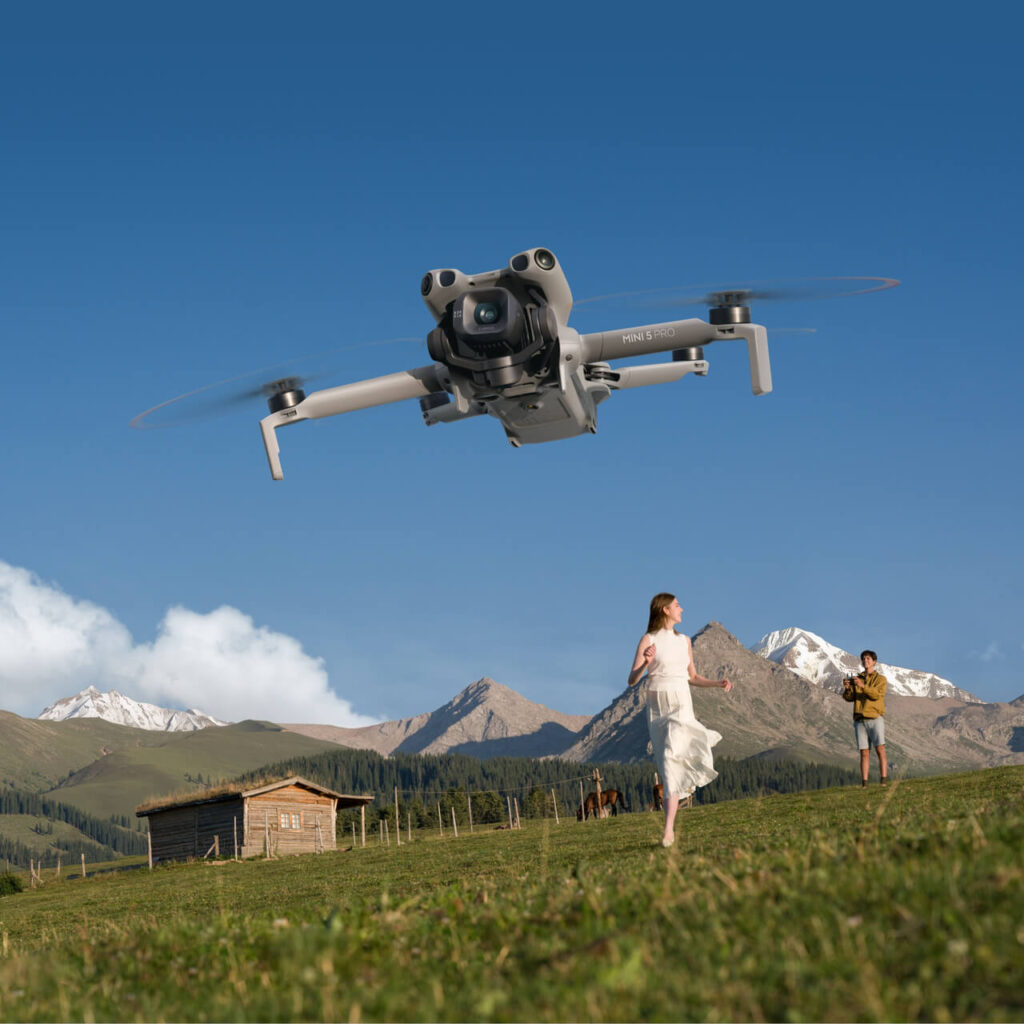
Silky-Smooth Slow Motion (4K/120fps)
The Mini 5 Pro elevates its cinematic capabilities with support for 4K video at 120 frames per second (fps), a notable upgrade from the Mini 4 Pro’s 4K/100fps limit. This higher frame rate allows content creators to slow down footage even further in post-production, producing exceptionally smooth and dramatic slow-motion sequences. This feature gives editors greater creative flexibility for capturing fast-moving subjects or adding a cinematic flair to any action shot. The drone also supports Full HD (1920×1080) recording at up to 240fps for even more extreme slow-motion effects.
The Power of 10-Bit Color
A significant advancement for videographers is the drone’s ability to record 10-bit video using the efficient H.265 codec. In practical terms, 10-bit color captures over one billion shades of color, a massive increase from the 16.7 million available in standard 8-bit video. This results in footage with incredibly smooth color gradients, eliminating the unsightly “banding” that can appear in skies or other subtle transitions. For editors, this provides far more latitude for color grading when shooting in professional profiles like D-Log M and HLG. In a crucial upgrade, the Mini 5 Pro now supports 10-bit color even in its
standard color profile, a tremendous benefit for users who want top-tier image quality and color depth without needing to perform complex color correction in post-production.
Higher ISO in Log Profiles
To further enhance its low-light video performance, the maximum ISO in the D-Log M and HLG color modes has been doubled from 1600 on the Mini 4 Pro to 3200 on the Mini 5 Pro. This allows creators to capture brighter and more detailed night scenes while still retaining the flat, neutral footage that log profiles are known for. This provides maximum flexibility for color grading, even when shooting in challenging, dimly lit urban environments.
The combination of these advanced video features effectively democratizes high-end aerial cinematography. High frame rates for slow motion and high bit-depth color for professional grading were once exclusive to larger, more expensive drones. While the Mini 4 Pro made significant strides, the Mini 5 Pro perfects this offering by increasing the frame rate and, most importantly, making 10-bit color accessible to everyone by including it in the standard profile. This dual-pronged approach means a beginner can shoot in the default mode and achieve footage with superior color depth, while a professional has the full suite of D-Log M tools at their disposal. This broadens the drone’s appeal across the entire user spectrum, from hobbyists to seasoned professionals, further solidifying its dominant position in the market.
4. Fly with Unprecedented Confidence: The Nightscape Sensing System
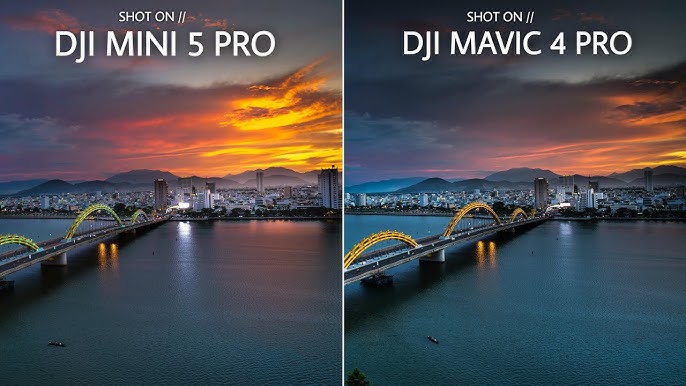
LiDAR: The Eyes in the Dark
Perhaps the most revolutionary safety upgrade on the Mini 5 Pro is its “Nightscape Omnidirectional Obstacle Sensing” system. The cornerstone of this new system is a forward-facing LiDAR (Light Detection and Ranging) sensor, a technology making its debut in the Mini series. This sensor works in concert with a comprehensive array of fisheye lenses on the front and rear, binocular lenses, and a 3D infrared sensor on the bottom of the aircraft. Unlike traditional vision sensors that rely on ambient light to perceive the environment, LiDAR actively emits pulses of light to measure distances with extreme precision. This makes it vastly more effective in low-light, twilight, and even dark conditions where vision-based systems typically struggle or fail entirely.
Smarter, Safer Returns (RTH)
This advanced sensor suite translates into tangible improvements in flight safety, particularly for automated functions like Return to Home (RTH).
- Nighttime RTH: With the aid of LiDAR, the Mini 5 Pro can now reliably detect and avoid large obstacles, such as buildings or trees, during an automatic RTH procedure at night. The system intelligently adjusts the drone’s altitude and flight path to ensure a safe journey back to its takeoff point, even in dimly lit urban environments.
- Non-GNSS RTH: In a groundbreaking development, the drone can now perform a safe return even without a satellite signal. By leveraging real-time vision positioning and map construction technologies, the Mini 5 Pro memorizes its flight path when adequate lighting is available. If it loses its GNSS connection—a common issue when taking off from balconies or in “urban canyons”—it can retrace its steps visually to navigate safely back home.
Enhanced Positioning
Flight stability and positioning are further improved by the inclusion of L1 + L5 dual-band GNSS. This allows the drone to connect to more satellites simultaneously, resulting in a stronger, more stable signal and more precise positioning during flight.
The addition of LiDAR is more than just a safety feature; it is a confidence-enabling technology. A drone can possess the world’s best low-light camera, but that camera is rendered useless if the pilot is too apprehensive to fly near obstacles in the dark for fear of crashing. Previous Mini drones, while equipped with obstacle avoidance, saw the performance of these systems degrade significantly as light faded. By incorporating LiDAR, DJI provides pilots with the assurance that the drone can perceive and react to its environment even after sunset. This crucial technological link makes the 1-inch sensor’s incredible nightscape performance a practical, usable feature for the average user, not just an impressive specification on a data sheet. This synergy between imaging and sensing is where the true innovation of the Mini 5 Pro is found.
5. Performance, Power, and Endurance Upgrades
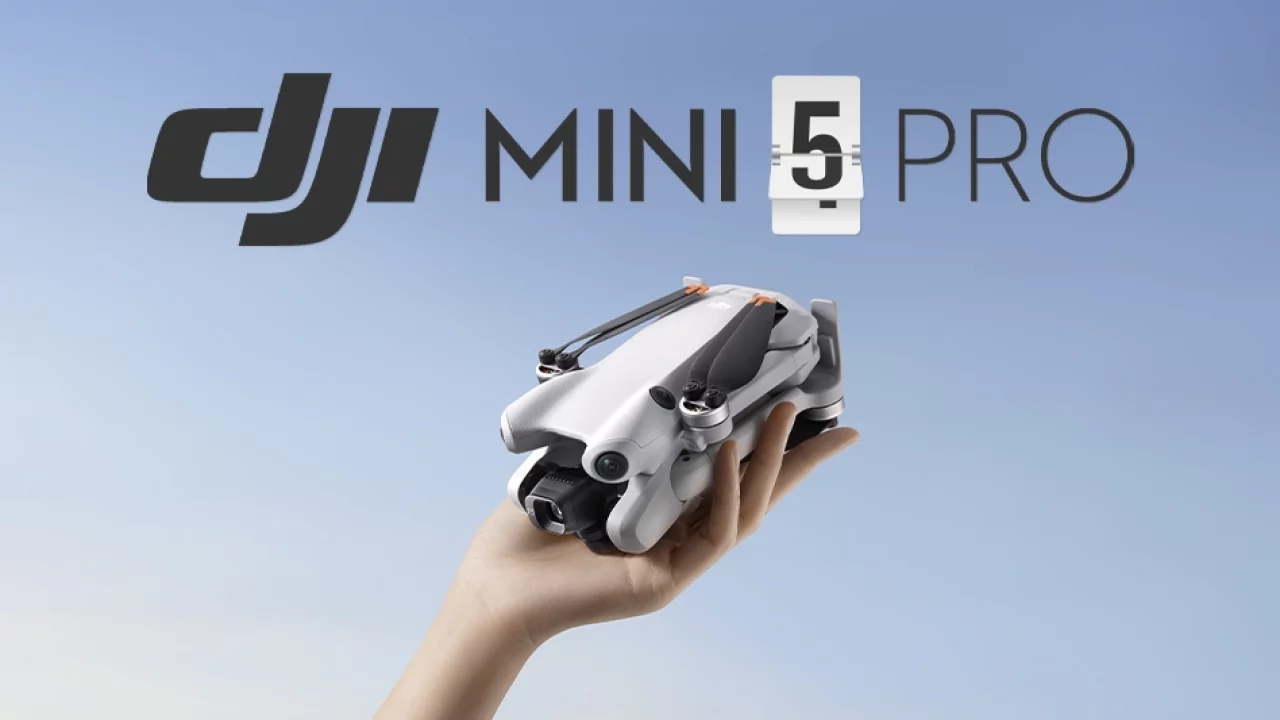
Class-Leading Flight Times
The Mini 5 Pro offers two distinct battery options to cater to different pilot needs. The standard Intelligent Flight Battery provides up to 36 minutes of maximum flight time, a respectable two-minute increase over its predecessor. The real headline, however, is the optional Intelligent Flight Battery Plus, which pushes the drone’s endurance to an industry-leading 52 minutes of flight time, the longest of any consumer DJI drone. This extended duration allows for more ambitious flights and greater creative freedom without the constant worry of a dwindling battery.
The Weight Paradox
This exceptional flight time comes with a critical trade-off. To achieve the 52-minute endurance, the Intelligent Flight Battery Plus pushes the drone’s takeoff weight significantly over the 249-gram limit, thereby negating its primary regulatory advantage in many regions. Furthermore, DJI has, for the first time, disclosed a manufacturing tolerance of ±4 grams for the standard configuration. This means that some units equipped with the standard battery could potentially tip the scales at just over 250 grams right out of the box, a detail that pilots must be aware of. This effectively forces owners to verify their drone’s weight to ensure compliance.
This subtle but significant shift indicates a change in philosophy for the Mini line. DJI is now clearly prioritizing peak performance, giving users a distinct choice: maintain the sub-250g advantage with excellent performance, or exceed the weight limit to unlock class-leading endurance. The “Mini” identity is no longer solely about regulatory convenience; it is about packing the maximum possible power into the smallest possible airframe, even if it occasionally tips the scales.
Conquering the Elements
The Mini 5 Pro is not just a fair-weather flyer. Its performance has been boosted across the board, making it a more robust and capable aircraft in challenging conditions. Wind resistance has been improved to 12 m/s (approx. 26.8 mph), up from 10.7 m/s on the Mini 4 Pro. Its top horizontal speed reaches up to 19 m/s (approx. 42.5 mph) with the Plus battery, and its maximum ascent speed has been doubled to an impressive 10 m/s. These enhancements give the drone a more powerful and responsive feel in the air.
O4+ Transmission System
Communication between the controller and the drone is handled by the upgraded DJI O4+ video transmission system. This ensures a stable, low-latency video feed over a range of up to 20 km (FCC compliant). A key improvement with O4+ is its ability to transmit a 10-bit HDR video feed directly to the controller’s screen, allowing pilots to see a more accurate representation of the high-dynamic-range footage they are capturing.
6. Creative Freedom and Intelligent Flight
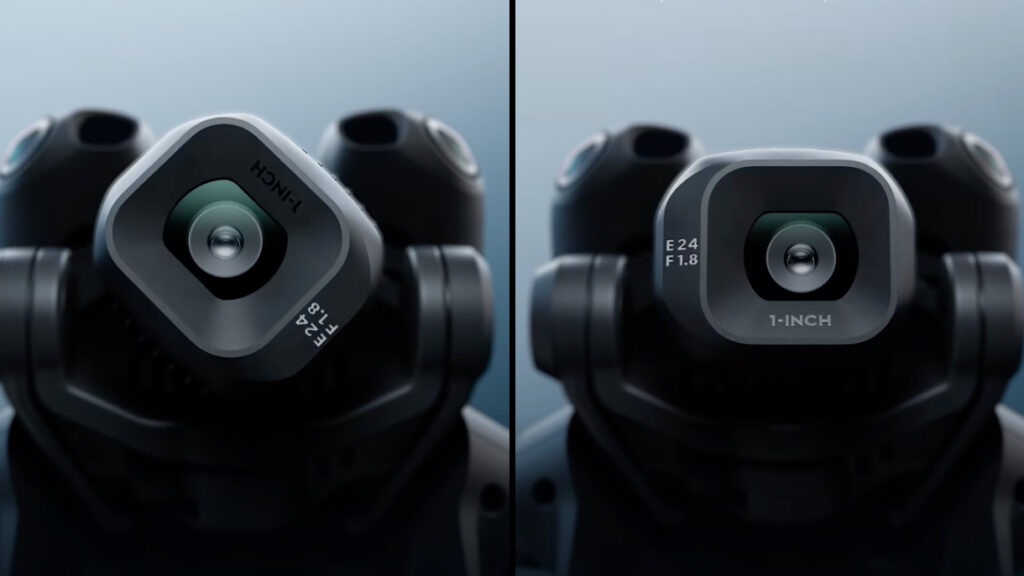
The 225° Rotating Gimbal
A major creative enhancement on the Mini 5 Pro is its new 3-axis gimbal, which now supports a wide-angle 225° roll rotation. This allows pilots to execute dynamic, rotating camera movements reminiscent of Hollywood-style “Dutch angle” shots, adding a unique and compelling visual element to their footage. This rotation can be controlled manually for precise framing or can be integrated seamlessly into automated flight modes like the new QuickShot Rotate, making complex shots accessible to everyone.
True Vertical Shooting for Social Media
Returning from the Mini 4 Pro is the indispensable True Vertical Shooting feature. The gimbal can physically rotate the camera 90 degrees to capture content in a native vertical orientation. This uses the full sensor to record vertical video and photos at maximum resolution, eliminating the need for quality-degrading digital cropping in post-production. It is an essential tool for creators producing content for platforms like Instagram Reels, TikTok, and YouTube Shorts.
Upgraded ActiveTrack 360°
DJI’s renowned subject-tracking system, ActiveTrack 360°, has been made even smarter. The system can now automatically detect specific sports scenarios, such as cycling or skiing, and select the most appropriate tracking mode to ensure optimal framing and smooth camera work. The tracking algorithm itself has been enhanced to provide a better balance of speed, agility, and safety, with tracking speeds of up to 15 m/s now possible for following faster subjects.
Quality-of-Life Improvements
Several other thoughtful upgrades enhance the overall user experience. The drone now comes with a massive 42GB of internal storage, a significant increase from the paltry 2GB on the Mini 4 Pro, providing a reliable backup if a memory card is forgotten or full. Additionally, the Mini 5 Pro incorporates the Off-State QuickTransfer feature, which allows for high-speed wireless file transfers to a mobile device at up to 100MB/s, even when the drone is powered off.
This comprehensive suite of creative tools demonstrates a clear focus on the modern content creator. Social media platforms favor short, dynamic, and visually engaging clips. Features like the 225° roll and automated QuickShots empower even novice pilots to capture complex camera movements with a single tap. The improved ActiveTrack with scenario detection automates the difficult task of framing a moving subject, a crucial capability for solo creators filming themselves. Paired with True Vertical Shooting, these features position the Mini 5 Pro as the ultimate all-in-one content creation tool, drastically reducing the level of manual piloting skill required to achieve professional-looking results.
7. DJI Mini 5 Pro vs. DJI Mini 4 Pro: Is It Worth the Upgrade?

For current drone owners, especially those with a Mini 4 Pro, the central question is whether the new model justifies the investment. A direct comparison reveals that the Mini 5 Pro is more than an iterative update; it is a substantial leap forward in several key areas.
Head-to-Head Specification Table
The following table provides a clear, at-a-glance comparison of the most critical specifications between the DJI Mini 5 Pro and its predecessor, the DJI Mini 4 Pro.
| Feature | DJI Mini 5 Pro | DJI Mini 4 Pro |
| Take-off Weight | 249.9g (Standard Battery) | < 249g |
| Sensor Size | 1-inch CMOS | 1/1.3-inch CMOS |
| Image Resolution | 50 MP | 48 MP |
| Max Video | 4K/120fps | 4K/100fps |
| Color Profiles | 10-bit D-Log M, HLG, Standard | 10-bit D-Log M, HLG |
| Gimbal Rotation | 225° Roll, True Vertical | True Vertical (90°) |
| Sensing System | Nightscape Omnidirectional (with LiDAR) | Omnidirectional (Vision only) |
| Max Flight Time | 36 min (Standard), 52 min (Plus) | 34 min (Standard), 45 min (Plus) |
| Wind Resistance | 12 m/s | 10.7 m/s |
| Max Speed | 18 m/s (S-Mode) | 16 m/s (S-Mode) |
| Transmission | O4+ (20 km FCC) | O4 (20 km FCC) |
| Internal Storage | 42 GB | 2 GB |
Analysis of Key Differences
The data clearly shows significant advancements across the board.
- For Photographers: The upgrade to a 1-inch sensor is the single most compelling reason to switch. The difference in low-light performance, detail rendition, and overall image quality is substantial, moving the drone into a new league of photographic capability.
- For Videographers: The combination of true 4K/120fps for smoother slow motion, the availability of 10-bit color in the standard profile, and the creative potential unlocked by the 225° rotating gimbal makes the Mini 5 Pro a far more versatile filmmaking tool.
- For All Pilots: The LiDAR-powered Nightscape Omnidirectional Obstacle Sensing is a revolutionary safety feature. It fundamentally changes when and where one can fly with confidence, opening up new creative possibilities for night and twilight operations that were previously too risky for a Mini-class drone.
For owners of the Mini 3 Pro or older models, the upgrade to the Mini 5 Pro is a clear and compelling choice. The advancements in imaging, safety, and performance are transformative. For current Mini 4 Pro owners, the decision is more nuanced. If their creative work is frequently limited by low-light conditions, or if they desire more dynamic camera movements and smoother slow-motion video, then the upgrade is undoubtedly worthwhile.
8. The Elephant in the Room: U.S. Availability and International Pricing
The “Why”
A critical factor for a large segment of the market is that the DJI Mini 5 Pro, like the Mavic 4 Pro before it, is not officially available for sale in the United States at launch. This situation stems from ongoing regulatory and geopolitical tensions. DJI has been placed on the U.S. government’s “Entity List” over national security concerns and allegations related to surveillance, which the company denies. This has led to increased scrutiny from agencies like U.S. Customs and Border Protection and the potential for wider legislative bans, creating an uncertain market environment for new DJI products.
What It Means for U.S. Buyers
The practical implications for consumers in the U.S. are significant. There are no official sales through DJI’s U.S. online store or authorized retailers. Prospective buyers must rely on third-party resellers or import the drone from other regions, such as Canada or Europe. This can lead to inflated prices and, more importantly, creates potential challenges with warranty claims and accessing DJI’s Care Refresh damage protection program, as service may need to be handled through international facilities.
International Pricing and Kits
In markets where it is available, the DJI Mini 5 Pro is offered in several configurations. Pricing in Europe starts at approximately €799-€809 for the base kit.

- DJI Mini 5 Pro (Standard): Includes the drone, one Intelligent Flight Battery, and the DJI RC-N3 controller, which requires a smartphone for its display. Prices are around €809 or $769 USD in Canada.
- Fly More Combo (DJI RC-N3): Adds two extra batteries, a two-way charging hub, a shoulder bag, and more spare propellers for around €1,019.
- Fly More Combo (DJI RC 2): Swaps the standard controller for the upgraded DJI RC 2, which features a built-in high-brightness screen. This popular package is priced around €1,149 or $1,039 USD.
- Fly More Combo Plus (DJI RC 2): Includes the longer-lasting Intelligent Flight Battery Plus instead of the standard batteries for around $1,109 USD.
9. Full Technical Specifications
For those who require a comprehensive understanding of the drone’s capabilities, the following table details the full technical specifications of the DJI Mini 5 Pro.
| Category | Specification | Details |
| Aircraft | Takeoff Weight | Standard Battery: 249.9 g ± 4 g; Plus Battery: Approx. 295.7 g |
| Dimensions | Folded: 157×95×68 mm; Unfolded: 255×181×91 mm (L×W×H) | |
| Max Ascent Speed | 10 m/s (S Mode) | |
| Max Descent Speed | 6 m/s (S Mode, Standard Battery); 8 m/s (S Mode, Plus Battery) | |
| Max Horizontal Speed | 18 m/s (S Mode, Standard Battery); 19 m/s (S Mode, Plus Battery) | |
| Max Wind Resistance | 12 m/s | |
| Max Service Ceiling | 6000 m | |
| Max Flight Time | 36 minutes (Standard Battery); 52 minutes (Plus Battery) | |
| Camera | Sensor | 1-inch CMOS, 50 Effective Megapixels |
| Lens | FOV: 84°; Format Equivalent: 24 mm; Aperture: f/1.8; Focus: 0.5 m to ∞ | |
| ISO Range | Video (Normal): 100-12800; Video (D-Log M/HLG): 100-3200; Photo: 100-6400 | |
| Shutter Speed | 1/8000-2 s (for 12MP & 50MP photos) | |
| Max Image Size | 8192×6144 | |
| Video Resolution | 4K: up to 120fps; FHD: up to 240fps | |
| Color Modes | 10-bit D-Log M, HLG, Standard | |
| Digital Zoom | Up to 4x | |
| Gimbal | Stabilization | 3-axis mechanical (tilt, roll, pan) |
| Controllable Range | Roll: -135° to 90° (225° total range) | |
| Sensing | System Type | Nightscape Omnidirectional binocular vision system with forward LiDAR and bottom infrared sensor |
| Transmission | System | O4+ |
| Max Distance | 20 km (FCC), 10 km (CE) | |
| Battery | Standard Capacity | 2,788 mAh |
| Plus Capacity | 4,680 mAh | |
| Storage | Internal | 42 GB |
| SD Card Support | Up to 1TB |
10. Frequently Asked Questions (FAQ) about the DJI Mini 5 Pro
Is the DJI Mini 5 Pro under 250g?
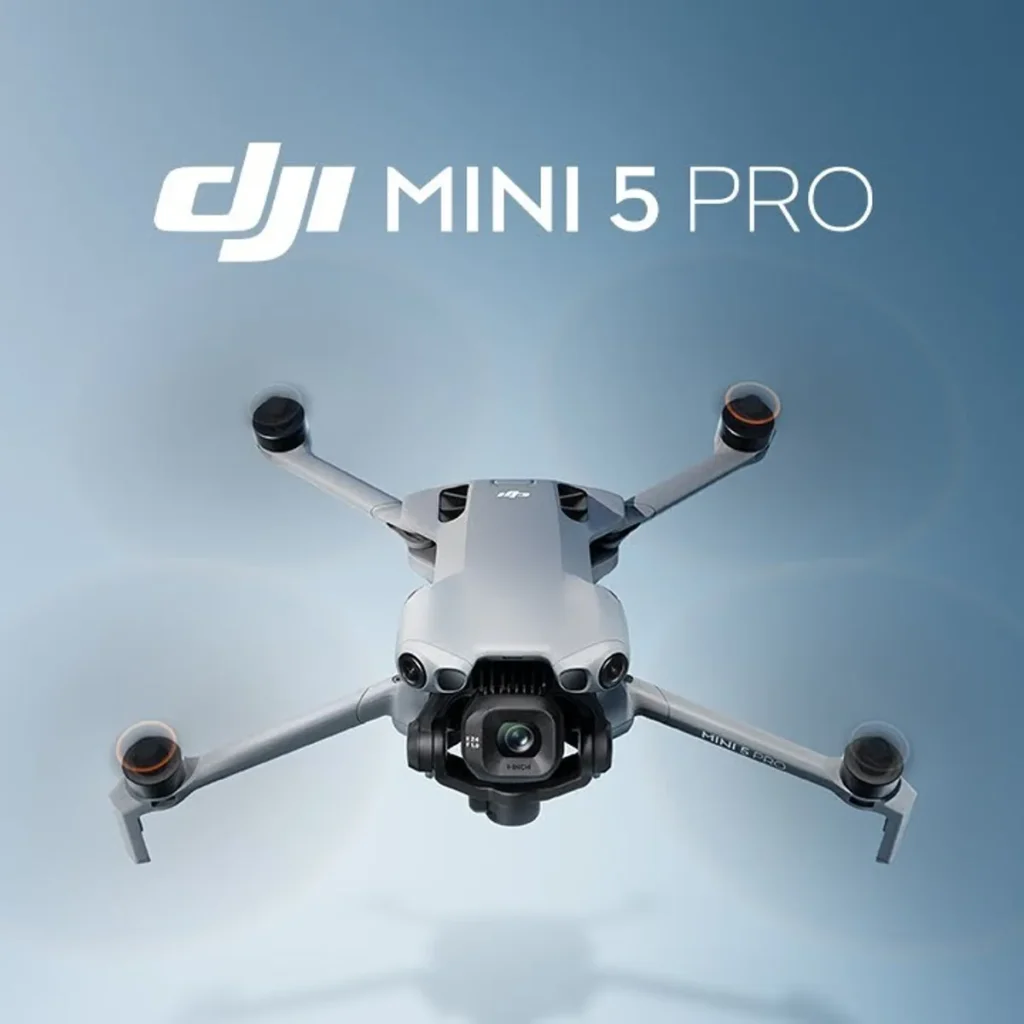
Yes, with its standard Intelligent Flight Battery, the DJI Mini 5 Pro has a takeoff weight of 249.9 grams, keeping it under the 250g regulatory threshold in most regions. However, DJI notes a manufacturing tolerance of ±4 grams. Using the optional Intelligent Flight Battery Plus for extended flight time will increase the weight to over 250g.
Can I use my DJI Mini 4 Pro batteries with the Mini 5 Pro?

Yes, batteries from the Mini 4 Pro are physically compatible with the Mini 5 Pro. However, DJI states that using older batteries may result in limited performance or features.
What is the main advantage of the 1-inch sensor?
The primary advantage of the larger 1-inch sensor is its superior ability to capture light. This results in significantly better image quality, especially in low-light conditions, with more detail, less noise, and a wider dynamic range compared to the smaller sensors in previous Mini drones.
How does LiDAR help with obstacle avoidance?
LiDAR (Light Detection and Ranging) actively sends out light pulses to measure distance, allowing the drone to “see” and detect obstacles with high accuracy even in dark or low-light environments where traditional vision-based camera sensors are ineffective. This makes night flying and automated functions like Return to Home much safer.
Is the DJI Mini 5 Pro a good drone for beginners?
Yes, the Mini 5 Pro is an excellent choice for beginners who have the budget for a premium drone. Its advanced Nightscape Omnidirectional Obstacle Sensing system provides a robust safety net, helping to prevent crashes. Its intuitive flight modes and high-quality automated shots make it easy to capture stunning content, making it a safe, powerful, and future-proof investment.
Why can’t I buy the DJI Mini 5 Pro in the United States?
The DJI Mini 5 Pro is not officially sold in the U.S. at launch due to ongoing regulatory issues and DJI’s inclusion on a U.S. government “Entity List.” This has created an uncertain market, leading DJI to withhold official sales through its U.S. channels.
What comes in the DJI Mini 5 Pro Fly More Combo?
The Fly More Combo typically includes the drone, three Intelligent Flight Batteries, a remote controller (either the RC-N3 or the RC 2 with a screen), a two-way charging hub, a shoulder bag, spare propellers, and an ND filter set (ND8/32/128).
11. Final Verdict: The New King of Compact Drones
The DJI Mini 5 Pro is an engineering marvel that fundamentally reshapes expectations for the sub-250g drone category. By successfully integrating a professional-grade 1-inch sensor, revolutionary LiDAR-based night sensing, and a host of performance upgrades into an ultralight airframe, DJI has created a tool that is without peer. Its strengths are clear and compelling: unparalleled image quality that rivals larger drones, a game-changing ability to fly safely at night, class-leading flight endurance, and a powerful suite of creative tools that empower pilots of all skill levels.
However, its excellence is tempered by two significant caveats. The first is the weight paradox: unlocking its maximum 52-minute flight time requires the Plus battery, which pushes the drone over the 250g threshold and into a more regulated class. The second, and more critical for a large market, is its lack of official availability in the United States, a complex issue that forces potential buyers to navigate third-party channels and accept potential risks regarding warranty and support.
Despite these challenges, the product itself is a triumph. The DJI Mini 5 Pro is the undisputed leader in the compact drone space. For serious hobbyists and professional content creators who demand maximum power with minimum weight and regulatory burden, it is the definitive choice. For beginners with a sufficient budget, its advanced safety features and exceptional image quality make it a superb and future-proof investment. The Mini 5 Pro is not just the best mini drone ever made; it is, without question, one of the best all-around consumer drones on the market today.
DJI :